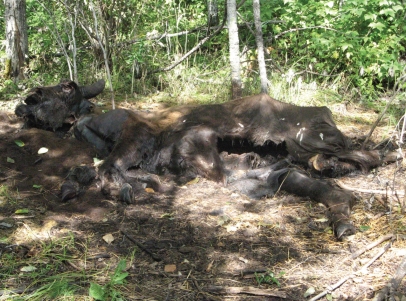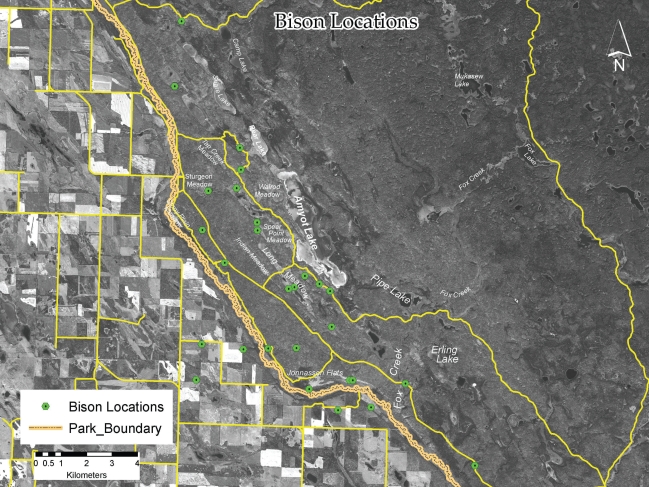During the summer of 2008, an outbreak of anthrax due to Bacillus anthracis was discovered in a herd of free-ranging plains bison (Bison bison bison) that resides in and around the southwestern corner of Prince Albert National Park in north central Saskatchewan. The area of the park where the bison typically range is fairly remote with no road access, but there are several hiking and horse trails. Four dead bison were initially reported to warden staff between August 6th and 9th by researchers who were conducting field studies on bison habitat use in the area. Anthrax was suspected, but had never been confirmed in this herd, and most of the carcasses were in an advanced state of decomposition (Figure 1) due to hot, summer weather conditions. As a result, diagnostic samples were not taken on these carcasses until August 14th. At this time, the remaining carcasses consisted primarily of skeletal remains, hair and pieces of hide in some cases. Two of the carcasses were completely disarticulated by scavengers and 2 were mostly intact. Samples of hide, hair mixed with soil, bones (proximal phalanges, vertebrae), and the entire ear were submitted to the Canadian Food Inspection Agency’s Animal Diseases Research Institute in Lethbridge, Alberta for anthrax culture and identification. Anthrax was confirmed by culture in all 4 of these animals as well as 4 additional fresh carcasses that were sampled between August 17th and 20th. Two of these latter animals were relatively fresh, and were found in typical “sawhorse” position; diagnosis was made on jugular blood and swabs collected from the nose and rectal area.
Figure 1.
Decomposed adult bull plains bison positive for anthrax in early August, 2008.
Ground surveillance was conducted on both horseback and all-terrain vehicle between August 15th and September 29th, while 4 aerial surveillance flights using a Bell 206B helicopter were conducted over the area between August 18th and 27th. In total, 28 bison carcasses were found in and around the park between August 3rd and September 16th (Figure 2). No further diagnostic samples were taken on the remaining bison carcasses after anthrax was confirmed. Five of the 28 carcasses were found outside of Prince Albert National Park on private lands adjacent to the park. One adult female bison with a GPS radio-collar apparently died on August 5th, but wasn’t located until several weeks later. Of the bison carcasses found, 14 (50%) were adult males, 11 (39.3%) were adult females, and 3 (10.7%), 1 of which was a calf, were of unknown sex. Based on these findings, it was estimated that most of these bison died over a 3-wk period between August 1st and August 21st. One black bear (Ursus americanus) cub and 1 unidentified wolf (Canis lupus) carcass were also near positive bison carcasses (within 500 m), but B. anthracis could not be cultured from the bear remains and results are pending for the wolf.
Figure 2.
Locations of bison carcasses discovered in and around Prince Albert National Park in the summer of 2008.
This is the first reported outbreak of anthrax in this herd of bison, which is the only free-ranging herd of plains bison found within their historic range in Canada. Plains bison were reintroduced to this area by the Saskatchewan government in an area northeast of the park in 1969. The herd has grown steadily since then from a nucleus of 10–20 animals to an estimated 400 bison currently. This outbreak was preceded by a significant anthrax outbreak in domestic cattle, bison, horses, cervids, sheep, pigs, and goats that occurred in Saskatchewan primarily south and east of the park during the summer of 2006, resulting in 804 livestock deaths on 153 premises (1). Sporadic cases occurred in cattle herds in 2007 throughout Saskatchewan and in cattle and bison herds near the park boundary in July 2008 (2). One captive bison herd on the eastern park boundary lost 8 animals to anthrax in the last week of July 2008 and 1 cattle herd had 1 positive case on the west side of the park in early August (2). Strain typing has not been completed to date to determine if there is an epidemiologic link between the cases in domestic and wild animals.
Anthrax is endemic in wood bison in northern Alberta and southern Northwest Territories with regular outbreaks having occurred in favorable weather conditions since 1963 (3). However, as far as we are aware, anthrax has not been reported in free-ranging plains bison herds in Canada previously, although outbreaks sporadically occur in domestic bison herds throughout the prairies. Anthrax outbreaks typically occur in years with hot, dry conditions often in conjunction with significant precipitation prior to this (3,4). The 2006 Saskatchewan outbreak was preceded by a winter and fall with abnormally heavy precipitation followed by dry conditions during the summer (1). Carcass treatment was implemented during this outbreak to reduce spore formation and contamination in the hope that this will reduce the risk of future outbreaks. Treatment consisted of both burial and incineration. Fresh carcasses were treated with up to 10 L of 10% formaldehyde and covered with a tarp to prevent scavenging and to allow putrefaction to kill the vegetative form of the bacterium, which is believed to occur if the carcass remains intact (5). Four of the 5 carcasses outside the park on private land were buried in deep pits dug at the site where the carcasses were found. The 23 bison carcasses located within Prince Albert National Park were all incinerated with a combination of locally cut wood and a slurry of up to 200 L of Jet A fuel with PetroGel up to 3 times, as access to the carcasses was limited. The World Health Organization recommends burning carcasses rather than burying when possible to reduce the chance of spores resurfacing years later (5). Of particular note in this case, is the fact that anthrax could be successfully cultured from significantly decomposed carcasses. Taking multiple tissues from several sites, especially where blood has accumulated will likely increase the chance of diagnosis in these cases.
This outbreak is almost identical to 1 reported in June of 2006 in the Slave River Lowlands in the Northwest Territories (4), where 28 wood bison died of anthrax over a 2-wk period from a herd of approximately 350. Anthrax outbreaks will likely continue to occur in this area of Saskatchewan and routine surveillance will likely occur in future to detect outbreaks quickly. It is important to remind veterinarians and cattle producers of the ongoing risk of anthrax in this area and the importance of annual vaccination for domestic animals at risk.
References
- 1.Himsworth CG, Argue CK. Anthrax in Saskatchewan 2006: An outbreak overview. Can Vet J. 2006;49:235–237. [PMC free article] [PubMed] [Google Scholar]
- 2.Canadian Food Inspection Agency [Web site] [Last accessed October 24, 2008];Anthrax update — latest information [updated August 28, 2008] Available at http://www.inspection.gc.ca/english/anima/heasan/disemala/anthchar/situatione.shtml.
- 3.Hugh-Jones ME, de Vos V. Anthrax and wildlife. Rev Sci Tech. 2002;21:359–383. doi: 10.20506/rst.21.2.1336. [DOI] [PubMed] [Google Scholar]
- 4.Nishi JS, Ellsworth TR, Lee N, Dewar D, Elkin BT, Dragon DC. An outbreak of anthrax (Bacillus anthracis) in free-roaming bison in the Northwest Territories, June–July 2006. Can Vet J. 2007;48:37–38. [PMC free article] [PubMed] [Google Scholar]
- 5.World Health Organization Epidemic and Pandemic Alert Response Website. Turnbull P, editor. [Last accessed October 24, 2008];Anthrax in humans and animals — 4th ed. C 2008. Available at http://www.who.int/csr/resources/publications/AnthraxGuidelines2008/en/index.html. [PubMed]




